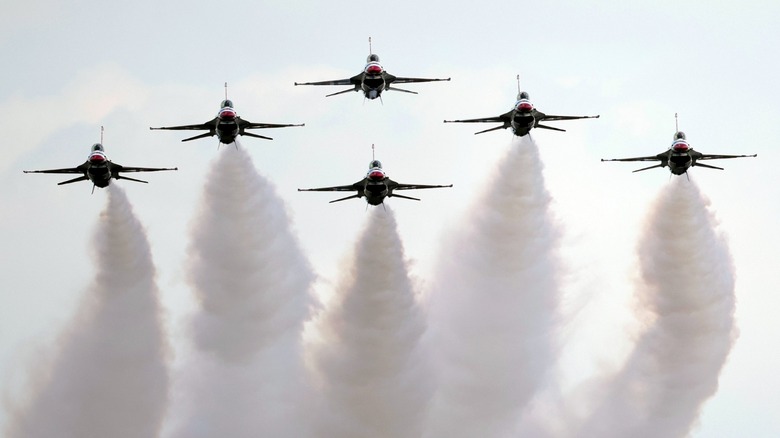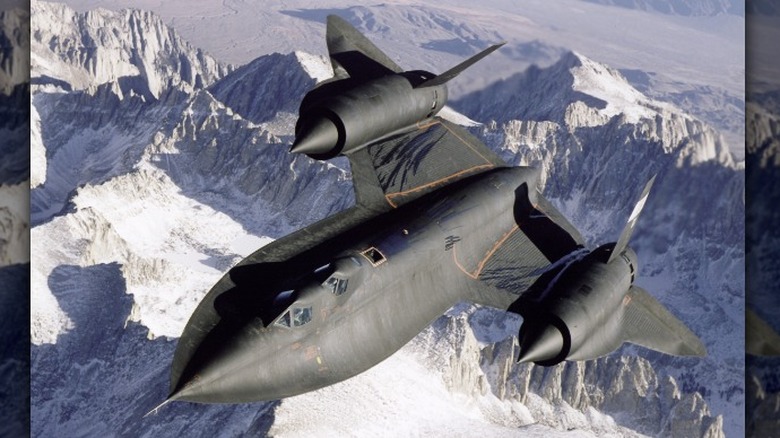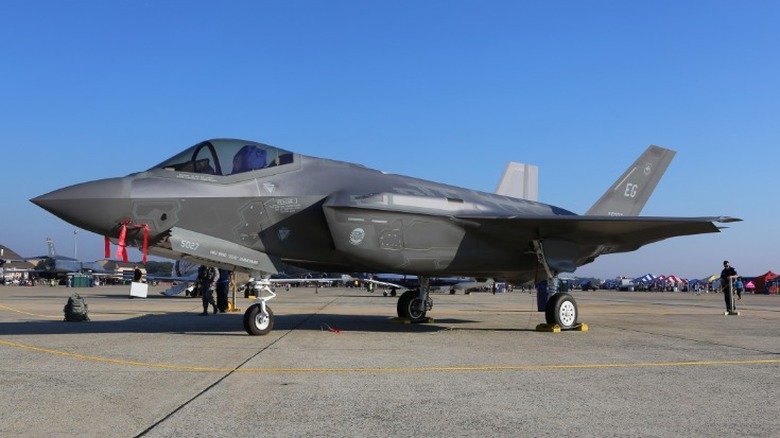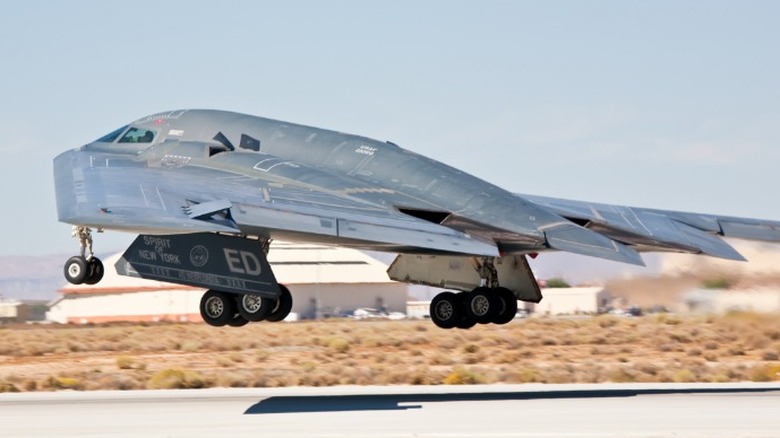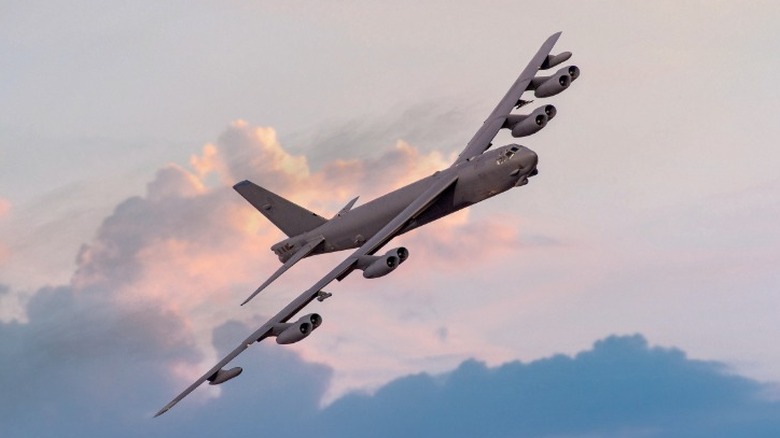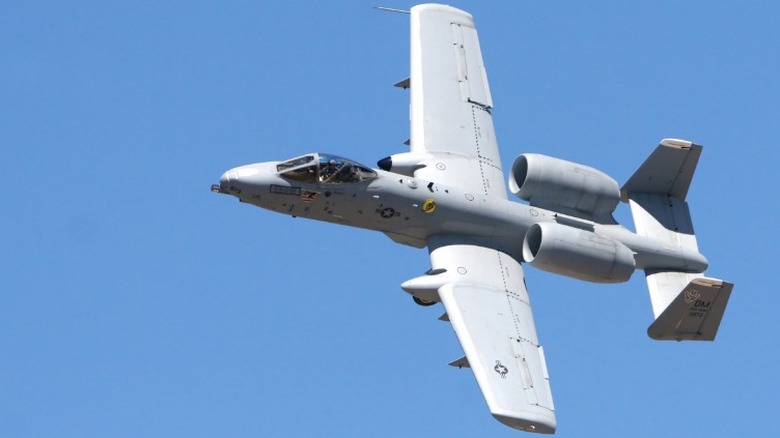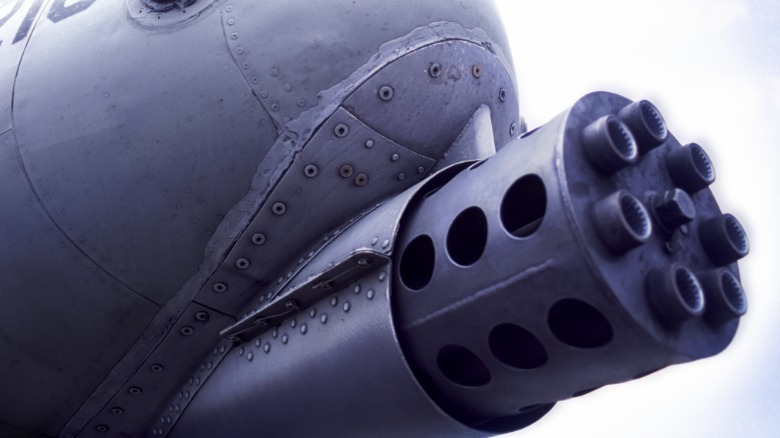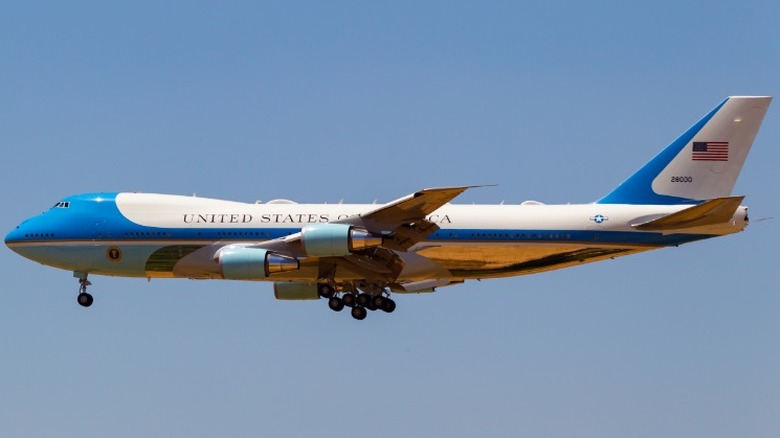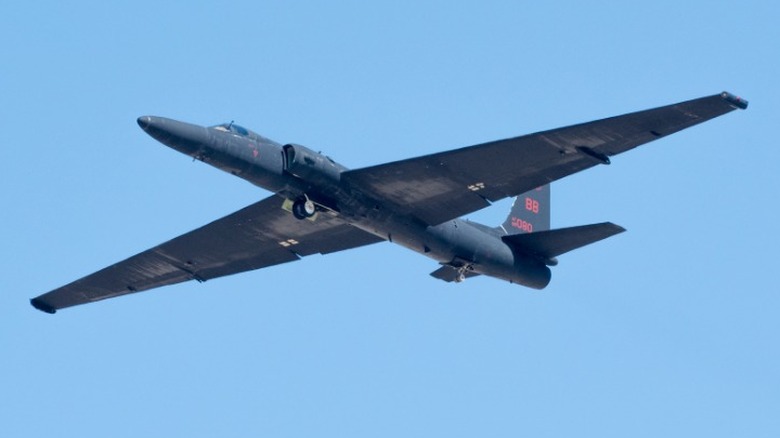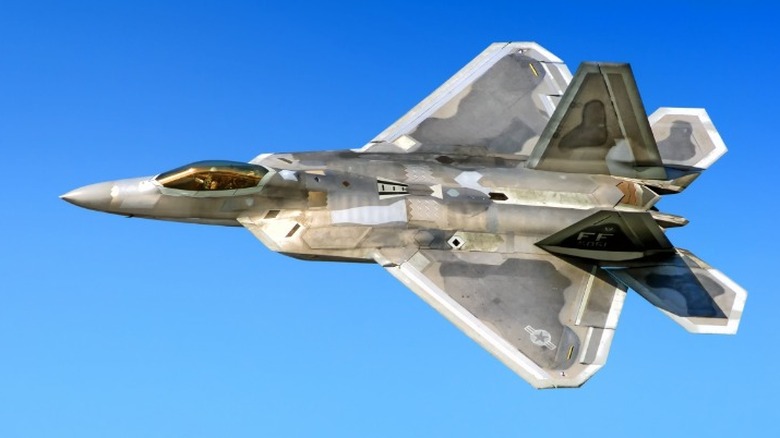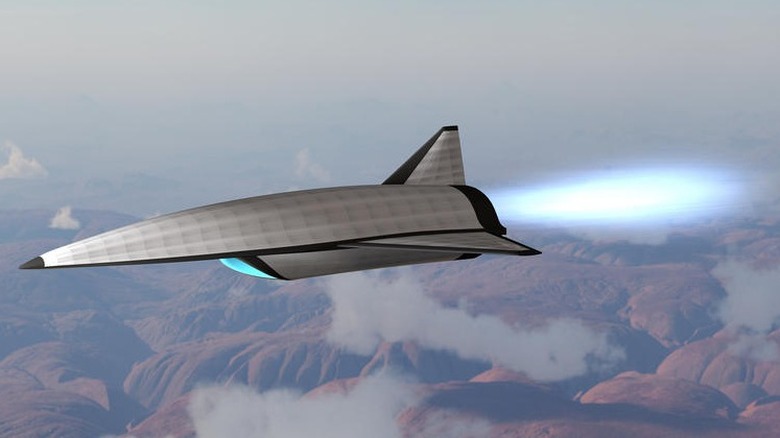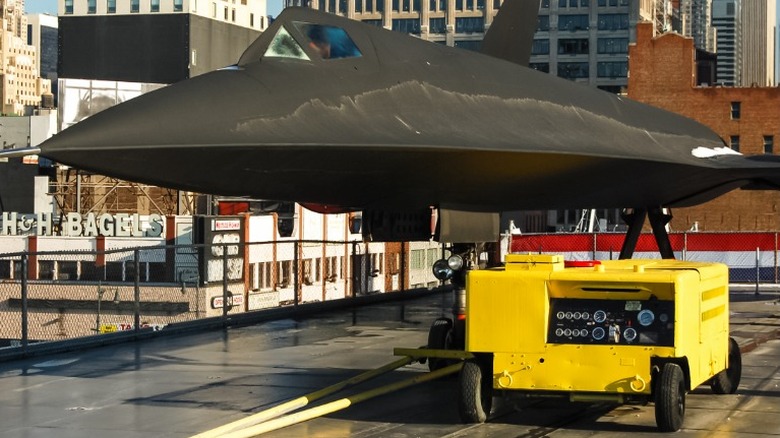Famous Vehicles Of The Air Force And Their Most Ridiculous Features
The United States Air Force can trace its history back to 1909 when the U.S. Army Signal Corps bought the first military aircraft in the world, a Wright Military Flyer. At first, military aircraft were used for observational and reconnaissance purposes but were fully armed by World War I. Aircraft became a vital part of all militaries in the following decades and became crucial in the fight against fascism and tyranny during World War II. It was two years after that war ended that the Air Force was officially created, removing the Air Signal Corps from the Army's purview into an independent branch of the armed forces.
While the development of aircraft advanced steadily with impressive improvements in the pre-war era, the experimental, prototype, and production aircraft created by the Air Force have been the most advanced machines on the planet. While the Air Force inventory consists of the most capable fighting vehicles in the world, it comes at a great cost to taxpayers, around $230 billion annually as of 2023. Furthermore, innovation in military aviation in the Air Force is cutting-edge, and many of the most technologically advanced aeronautical capabilities begin with Air Force projects, although there are still possibly hundreds we will never know about as they are classified top secret. Considering the information that is declassified and public knowledge, these are the most famous Air Force vehicles and the most ridiculous of their features.
SR-71 Blackbird
One of the most impressive vehicles to come out of the Lockheed Skunk Works experimental and clandestine development team is the SR-71 Blackbird. Originally planned as a high-speed and high-altitude reconnaissance aircraft, its initial designation was A12 and it was flown by the CIA, not the Air Force. However, the Air Force did start flying this plane in 1968, and it was then that it received the Blackbird moniker, so named for the black paint that would absorb radar signals, radiate heat into the atmosphere, and provide some camouflage in dark skies.
The SR-71 flew with no armaments as it was not a fighter or bomber. It was produced and used for intelligence gathering, and its most effective defensive capability is also its most prominent feature, sheer speed. The SR-71's dual Pratt and Whitney J-58 engines powered this plane up to a safe cruising speed of Mach 3.3 at 85,000 feet. Rather than fighting enemy aircraft, it was meant to simply outrun them. The SR-71 is still the fastest jet-powered aircraft ever made and it served in dozens of missions from the '60s to the late '80s providing vital information about our adversaries around the world. In its final flight, the SR-71 bearing serial number 61-7972 was flown from Los Angeles to Washington D.C. in just one hour, four minutes, and 20 seconds, a journey that would have taken several weeks just a century before.
F-35A Joint Strike Fighter
The newest of cutting-edge American military aircraft is the Lockheed Martin F-35 Joint Strike Fighter. It is built to serve in different branches of the armed forces with variations in construction depending on its mission. The Air Force variant is the F-35A. Constructed with stealth technology and a single jet engine with thrust vectoring, the F-35A is packed with an endless list of high-tech equipment that makes it a formidable challenger to any non-NATO vehicle in existence.
The F-35A is capable of Mach 1.6 and has a range of 1,350 miles. It is armed with a 25mm four-barrel cannon and carries its primary munitions in an internal bomb bay with additional payload capacity attached to the wings. However, while this plane can deliver powerful explosives, the F-35 coup de grâce comes from its advanced communications. A suite of sensors and communication modules relay a wide variety of information to the pilot through an advanced helmet projecting information onto the helmet's visor rather than a traditional head-up display on the canopy. This gives pilots an augmented real-time view of their surroundings that is never out of view. Furthermore, the F-35 has networking capabilities allowing it to send and receive data between other aircraft as well as vessels on the ground and water, making it a powerful communications hub with a bird's eye view. There may be other jets more maneuverable or faster, but the combined capabilities of the F-35 make it the most powerful and advanced fighter ever built.
B-2 Spirit
Boeing's B-2 Spirit is a long-range bomber capable of carrying a large payload and entering hostile territory undetected due to its advanced stealth capabilities. The seeds of its development date back to the Vietnam era, with production commencing in the twilight of the Cold War. The mission of the B-2 is that of a long-range bomber, capable of delivering a large payload of munitions originating from afar and entering hostile territory hidden from radar by stealth technology. It is operated by a crew of two and powered by quad GE turbofan engines mounted internally. The exterior is composed of advanced composite materials and special coatings that contribute to its stealth attributes along with its most significant feature, its construction as a flying wing, an aircraft body composed entirely of two wings with an integrated cockpit and lacking a tail and rudder.
Attempts to build a flying wing are as old as flying itself, with some of the first viable models built by Northrop in the '30s. The primary benefit of this design is efficiency, which makes it perfect for a long-range bomber. While plans for a plane such as the B-2 were around for decades, none were put into production due to inherent instabilities of the design, but they were alleviated by computerized fly-by-wire controls. Due to a mix of efficient design and stealth technology, the Air Force was capable of completing missions to Sarajevo in the '90s that originated from Missouri and later to Afghanistan in one of the longest missions ever executed without in-flight refueling.
B-52 Stratofortress
With the end of WWII and the rise of the nuclear age, the U.S. put the development of long-range bombers capable of delivering nuclear warheads on a priority status. Plans to build a turboprop plane had been envisioned at the start, but positive developments with Pratt and Whitney's new turbojet engines help push plans toward building a new jet-powered aircraft. First flights commenced in 1952 and the planes would go into service by 1961. It is a giant of a plane powered by eight turbofan engines coupled in four pods that allow the plane to haul a payload of 70,000 pounds with a range of 8,800 miles at a maximum altitude of 50,000 feet. It was the most impressive plane of its kind when it entered service and remains so today.
The B-52 has been involved in every major conflict in which the U.S. was involved, including Vietnam and Iraq. It is capable of carrying bombs, missiles, mines, and smart weapons, but its most impressive feature is longevity. The B-52 has been upgraded and updated many times, but it is still in service and recent upgrades put its service life into the 2050s. The current B-52 is fully outfitted with modern avionics and advanced communications and radar systems, and the upgraded systems will take advantage of the latest technology to keep the aging airframe up to strict Air Force standards. It is an astonishing fact that these planes will have been in service for nearly a century by the time they are retired.
A-10 Thunderbolt II
Planes such as the F-35 and F-16 tend to get a lot of attention from fighter jet enthusiasts, but it would be folly to overlook the A-10 Thunderbolt II, affectionately called the Warthog, and the vital role it can play in executing a mission. Development of this jet commenced in the '70s when Fairchild-Republic Company was chosen to fulfill the contract of building a plane for close air support, coming into a ground fight to protect infantry and tank forces engaged in battle. Therefore, it is much slower than something like an F-16 and it is the most heavily armored vehicle in the Air Force inventory. Furthermore, it does not feature a swept-wing design as that is best suited for high-speed and high-altitude flying. What the A-10 Warthog does have is a really big gun.
When considering the design of the Warthog, one could argue that it is less a plane designed to carry a gun than a gun designed to carry a plane. Its main cannon is a seven-barrel 30mm Gatling gun that is hydraulically operated and capable of shooting 3,900 rounds per minute but can also carry missiles with advanced targeting systems. For protection, designers added redundancy in the flight control systems with protection for the fuel tanks and titanium panels to protect the pilot, making this aircraft capable of surviving while taking on heavy fire in a manner few other planes can. Perhaps the coolest part of this plane is the awesome "BRRRT" sound it makes when unleashing its ammo from the sky.
Boeing VC-25
Based on the widebody Boeing 747, the VC-25 is commonly known by its call sign of Air Force One. Any plane carrying the president uses this call sign, but that is almost always one of two VC-25 models, which is only like the civilian passenger airliner from the outside. The interior is specially outfitted with an array of conveniences, luxuries, and security like no other plane in the world. While we do have general information about the features of this plane, the details and specifications are all highly classified.
President George H. W. Bush was the first to fly in the VC-25, and two of them remain in service but are scheduled to be replaced by 2024 with a modified 747-800. The features that make the VC-25 special and unique are what allow the president to continue leading the country in the air, even in times of crisis. The president has a suite of communications tools to keep in contact with leaders of the armed forces as well as senior staff in the executive branch who can execute orders in real time. Furthermore, it is equipped with a medical suite and staffed with a doctor who can perform complex procedures while in the air. Less critical but still important features include a galley to keep everyone on board well-fed and a suite with a bed to allow the president to rest on long excursions. It is like no other passenger jet in the world and is also the most heavily defended as every flight is accompanied by Air Force fighter jets ready to eliminate any threat long before it becomes a problem.
Lockheed U-2
Before the proliferation of satellites, military leaders of the U.S. needed ways to keep tabs on its adversaries, particularly the Soviet Union. Lockheed's Skunks Works developed a high-altitude plane in secret, delivering a production model in 1955. But the first planes were used by the CIA and were initially flown over the Soviet Union, gaining a wealth of intelligence. However, these flights ended abruptly when Gary Powers was shot down over the Soviet Union in 1960. The U-2 continued mission support flights in other areas for years after that. The Air Force first acquired its U-2 aircraft in 1994.
Despite the development of modern stealth aircraft and advanced satellites, the U-2 is still in service. What makes this plane so valuable as a military asset is its ability to cruise at an altitude of over 70,000 feet. It is lightweight with a thin fuselage and its 103-foot wingspan all contribute to this ability. They have been upgraded with modern avionics and sophisticated sensors and imaging equipment such that the U-2 continues to provide useful intelligence for the modern battlefield.
The U-2 has fought off attempts at replacement several times but plans to update and replace it are still on the horizon. Regardless of how effective new proposals may be, as long as it continues to deliver what other vehicles cannot, the Air Force is likely to keep this one in service.
F-22 Raptor
While the F-35 is the newest and most technologically advanced vehicle in the Air Force fleet, the F-22 Raptor is a perfect complement possessing equally impressive technology while serving a different role within the fleet. Entering into service in 2005, the F-22 is a fifth-generation stealth fighter and features some of the most advanced design features in the world. It is powered by two turbofan engines with afterburners and thrust vectoring nozzles that give it high speed and maneuverability. To maintain stealth, its weapons are stored in an enclosed bomb bay but can carry additional munitions on hard points on the wings. Its range is 1,850 miles and it cruises up to Mach 2 and can maintain a speed up to Mach 1.5 with supercruise, which allows it to maintain supersonic flight without using an afterburner while using significantly less fuel.
The most significant attribute of the F-22 is its extreme maneuvering capability. This plane is the Air Force's prime combat aircraft, ready to engage with the enemy using superior firepower combined with flying ability. While production of this aircraft ended with the introduction of the F-35, some in the defense community lament that decision as the F-22's abilities in establishing air superiority shine. Furthermore, the F-22's aerodynamic design and digital fly-by-wire controls make it the most agile fighter jet in the skies.
Expendable Hypersonic Multi-mission ISR
In development by the Air Force Research Laboratory is the next generation in high-speed flight. Air speeds of more than Mach 5, or hypersonic flight, are being researched for a new bomber capable of achieving up to Mach 10 at least partially to counteract the recent tests of hypersonic missiles by both China and Russia. However, an advantage of this vehicle would be the ability to use it again and again rather than launching a single-use missile at the cost of around $100 million.
This hypersonic effort known as Project Mayhem is to develop a "hypersonic multi-mission ISR [intelligence, surveillance, and reconnaissance] and strike platform," as reported by Popular Mechanics. The challenges inherent to hypersonic flight will require highly advanced engineering to overcome. For example, conventional jet engines produce thrust with a spinning compressor with fan blades that limits the maximum thrust possible. This could be overcome with scramjets that produce boost from fuel pressure alone, but lack sufficient thrust at lower speeds. Furthermore, the extreme heat produced at this speed requires advanced materials that are expensive to produce and often difficult to work with.
It will be some time before this is produced if it ever happens in the first place. Many engineering barriers must be overcome as well as wrangling funding from an oft-dysfunctional Congress. Regardless, the U.S. Air Force is not an institution that tends to let its adversaries have an upper hand in anything, so it is almost guaranteed the research will continue.
BONUS: AG-330 Start Cart
Of the few ground-based vehicles used by the Air Force besides its fleet of fuel trucks is the AG-330 Start Cart that was used for the SR-71 Blackbird. The Blackbird was not built with onboard starters, thus requiring an external mechanism to get the huge J58 turbofans spinning.
To get started, the engine had to be spun up to 3,200 RPM and TEB (triethyl-boron) would be introduced to induce combustion before the JP7 fuel could take over. This process requires a high level of torque, so start carts were produced using Buick 402-cubic-inch Wildcat V8 engines. The carts contained two engines with automatic transmissions coupled by a steel drive belt that spun a gear that transferred torque to a vertical shaft that locked into the starter gear on the plane. The engines could be started individually, but two carts were also used simultaneously to prep the aircraft for flight. Those that got to experience the starting of a Blackbird were greeted by the deafening noise of multiple 400-horsepower Buick Wildcats churning at around 4,800 RPM with straight pipe exhaust shooting flames three feet out either side.
The Buick engines were later replaced by the Chevrolet LS7 454, and the start carts were phased out altogether after adapting the Pneumatic Air starting system from Garrett Air Research.
